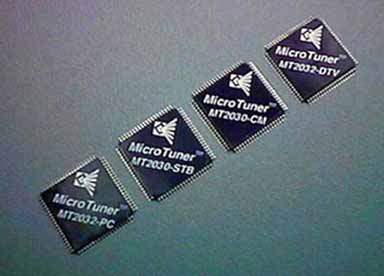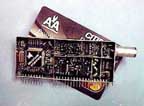Microtune Launches New Tuner, Module for Digital Set-Tops

Targeting the demands of the increasingly complex digital set-top box, Microtune (Plano, TX) has announced the availability of its third generation MicroTuner RF chip.
The MicroTuner 2030-series draws on technology derived from MicroTune's 1999 acquisition of Temic, a German-based supplier of RF-based technology for the PC, cable TV and automotive industries. The acquisition allows Microtune to evolve from a single-chip company to – in the words of Microtune CEO Douglas Bartek – a "total systems solutions provider."
The new chip features a 30% power reduction over previous versions of the MicroTuner, which debuted last year as the first dual conversion ASIC that supports both analog and digital signals. The chip also features significant performance improvements in phase noise, linearity, IF flatness and gain.
The improvements are targeting what IC development chief Bud Taddiken, VP of IC engineering for Microtune, says is more complex digital systems requiring sophisticated requirements for the front-end tuner. "Cable operators are moving from QAM 64 to 256 – many of these systems can barely handle this so they need a more powerful tuner," Taddiken says. "The spectrum is becoming increasingly crowded with new services such as cable telephony – you need tuners with higher performance."
Versions of the tuners are optimized for digital interactive set-tops, cable modems, PC/TV applications and DTV. The tuners, which are available now and priced by volume, support DOCSIS, QAM-256, 8-VSB, NTSC, PAL, DVB and DAVIC standards.
New Modules
 Microtune has also launched a new class of products called "MicroModules" that target OEMs for Open Cable-compliant applications. Designed to speed up development cycles, the MM8838 MicroModule is a credit card-sized RF subsystem that integrates the MicroTuner chip with additional functions and capabilities, including an out of band tuner and an upstream amplifier for two-way communications.
Microtune has also launched a new class of products called "MicroModules" that target OEMs for Open Cable-compliant applications. Designed to speed up development cycles, the MM8838 MicroModule is a credit card-sized RF subsystem that integrates the MicroTuner chip with additional functions and capabilities, including an out of band tuner and an upstream amplifier for two-way communications.
For OEM designer with limited RF expertise, the MicroModules provide a ready-to-implement RF front-end that can be "plugged" onto a PCB, motherboard or chassis. In addition, the module could shrink the physical size of the digital cable set-top box by a factor of 3, according to Taddiken.
The MM3383 MicroModule for digital, interactive cable set-top box will be available in June 2000. The MicroModules targeted for PC/TV, cable modem and DTV will be available later in the year.
Edited by Tom Butts
